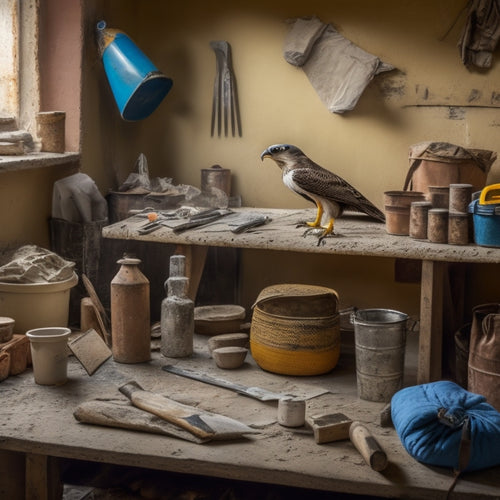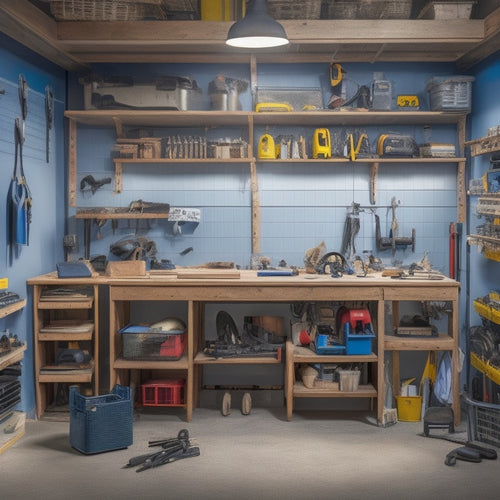
5 Best Tools for Cinder Block Home Renovation
Share
You'll need to prioritize safety and efficiency when tackling a cinder block home renovation project. Start with demolition and debris removal essentials like hard hats, pry bars, and a dumpster. Next, invest in cinder block cutting and shaping tools like diamond-coated saws and chisels. Mortar mixing and application tools, such as mortar mixers and trowels, will guarantee strong bonds. Don't forget surface preparation and cleaning tools like wire brushes and pressure washers. Finally, reinforce your structure with rebar, fiber mesh, and chemical anchors. By mastering these five tool categories, you'll be well on your way to a successful renovation - but there's more to explore to guarantee a professional-grade finish.
Key Takeaways
• Invest in a cinder block saw with a diamond-coated blade for precise and efficient cutting of cinder blocks.
• Utilize a mortar mixer to ensure consistent blending of mortar ingredients for strong and durable bonds.
• Employ a pry bar and wrecking ball for safe and effective demolition and dismantling of cinder block structures.
• Use a wire brush or scrub brush to remove loose debris and old mortar from surfaces, ensuring a smooth finish.
• Select a durable and heat-treated chisel for precise removal of small material amounts and shaping of cinder blocks.
Demolition and Debris Removal Essentials
When tackling a cinder block renovation project, you'll need to prioritize demolition and debris removal, starting with the right tools to dismantle existing structures and clear the area of rubble and hazardous materials.
You can't afford to compromise on safety, so make sure you've got the necessary safety equipment, including hard hats, gloves, safety glasses, and steel-toed boots. A dust mask or respirator is also a must-have when dealing with asbestos or lead-based paints.
For efficient waste disposal, invest in a dumpster or a large trash container to collect debris as you go. You'll also need a wheelbarrow or heavy-duty trash bags to transport heavy materials.
A pry bar, hammer, and wrecking ball will come in handy when dismantling existing structures, while a shovel and broom will help you clear the area of rubble and dust.
Don't forget to have a fire extinguisher on site, just in case. By having the right tools and equipment, you'll be able to tackle demolition and debris removal with confidence and control, setting yourself up for a successful renovation project.
Cinder Block Cutting and Shaping Tools
You'll need a range of specialized tools to accurately cut and shape cinder blocks to fit your renovation design, ensuring a precise fit and a professional finish.
Cinder block saws are a must-have for making straight cuts in the blocks. These saws typically feature a diamond-coated blade that can handle the abrasive nature of cinder blocks.
When it comes to curved or irregular cuts, you'll need a masonry blade or a diamond-grit blade on a circular saw.
For more precise shaping, you'll require shaping chisels. These handheld tools allow you to remove small amounts of material from the block, enabling you to fine-tune the shape and fit.
Shaping chisels come in various widths and are typically used in conjunction with a hammer or mallet. When selecting chisels, look for ones with durable, heat-treated blades that can withstand the rigors of shaping cinder blocks.
Mortar Mixing and Application Tools
Accurate mortar mixing and application require a set of specialized tools to guarantee a strong, consistent bond between the cinder blocks. As you begin your cinder block home renovation, it's important to have the right tools to make certain a professional-grade finish.
Here are some must-have tools for mortar mixing and application:
| Tool | Purpose | Benefit |
|---|---|---|
| Mortar mixer | Mixes and blends mortar ingredients | Consistent mix, reduced labor |
| Trowel | Applies and spreads mortar | Smooth, even application |
| Pointing trowel | Finishes and joints mortar | Precise, clean joints |
Mastering mortar mixing techniques and mortar application methods is vital for a successful renovation. With the right tools, you'll be able to achieve a strong, durable bond between the cinder blocks. Remember to follow proper mixing and application procedures to make certain a professional-grade finish. By investing in these specialized tools, you'll save time, reduce labor, and achieve a superior result.
Surface Preparation and Cleaning Tools
Before applying fresh mortar, thoroughly clean and prepare the cinder block surface to guarantee a strong bond. Any dirt, grime, or old mortar residue can compromise the integrity of the new mortar.
You'll need the right surface preparation and cleaning tools to secure a successful renovation. Invest in a wire brush or scrub brush to remove loose debris and old mortar from the cinder block surface.
For more stubborn residue, use a chemical-based surface treatment to dissolve and remove old mortar, grout, or efflorescence.
When it comes to cleaning techniques, a pressure washer can be an effective tool for blasting away dirt and grime. However, be cautious not to damage the cinder block surface with excessive pressure.
For more delicate surfaces, use a soft-bristled brush and a mild detergent solution to gently clean the area. Additionally, consider using a vacuum or blower to remove dust and debris from the surface.
Reinforcement and Anchoring Systems
Cinder block walls often require additional reinforcement and anchoring systems to guarantee structural integrity and stability, especially in areas prone to high winds, seismic activity, or heavy loads. As you plan your renovation, you'll need to evaluate various reinforcement techniques to verify your walls can withstand external forces. You'll also need to choose suitable anchoring methods to secure your walls to the foundation or adjacent structures.
| Reinforcement Techniques | Anchoring Methods |
|---|---|
| Rebar installation | Chemical anchors (e.g., epoxy-based) |
| Fiber mesh reinforcement | Mechanical anchors (e.g., sleeve anchors) |
| Shotcrete application | Post-installed anchors (e.g., adhesive anchors) |
When selecting a reinforcement technique, assess factors such as the wall's load-bearing capacity, soil conditions, and local building codes. For anchoring methods, choose options that suit the type of cinder block, wall thickness, and environmental conditions. By combining the right reinforcement and anchoring systems, you'll verify your cinder block walls are strong, stable, and secure. Remember to consult with a structural engineer or experienced contractor if you're unsure about the best approach for your specific project.
Frequently Asked Questions
Can I Use Cinder Blocks With Cracks or Damaged Areas in My Renovation?
When you're considering reusing cinder blocks with cracks or damaged areas, you'll want to assess their structural integrity first.
While it's possible to use repair techniques like epoxy injection or patching to fix minor cracks, severely damaged blocks can compromise your wall's stability.
You'll need to carefully evaluate the extent of the damage and decide whether to replace or repair the blocks to guarantee your renovation meets safety standards.
How Do I Ensure Proper Drainage in My Cinder Block Home Renovation?
'An ounce of prevention is worth a pound of cure.'
You'll avoid costly repairs by ensuring proper drainage in your cinder block home renovation.
Start by evaluating your home's slope and grading to direct water away from the foundation.
Implement effective drainage systems, like French drains or swales, and apply waterproofing techniques, such as sealants or membranes, to prevent water infiltration.
This proactive approach will safeguard your investment and give you peace of mind.
Are Cinder Block Homes More Prone to Pest Infestations Than Other Homes?
You're right to wonder if cinder block homes are more prone to pest infestations. The answer is, they can be.
Cinder block's porous nature and hollow cores create an entry point for pests, compromising your home's structural integrity.
To maintain control, prioritize pest control measures like sealing cracks, using caulk, and installing door sweeps.
Regularly inspect for signs of infestation, and consider hiring a professional if you suspect a problem.
Stay proactive to protect your home from unwanted critters.
Can I Renovate a Cinder Block Home to Achieve a Modern Aesthetic?
You've seen it done - like the 1950s cinder block home in Tampa that was transformed into a sleek, modern oasis.
You can achieve a similar modern aesthetic by incorporating design elements like large windows, metal accents, and minimalist decor.
Update the exterior with a fresh coat of stucco or paint, and consider adding a modern roofline to create a streamlined look.
With thoughtful aesthetic upgrades, you can turn your cinder block home into a contemporary showstopper.
Do Cinder Block Homes Require Special Insurance or Warranty Considerations?
When renovating a cinder block home, you'll need to take into account special insurance requirements and warranty options.
You'll want to research insurance providers that cater to non-traditional construction methods, as standard policies mightn't cover cinder block structures.
Additionally, look into warranty options that specifically address potential issues with cinder block, such as cracking or water damage.
Conclusion
As you near the end of your cinder block home renovation, remember that the right tools made all the difference.
From demolition to surface preparation, each stage required precision and efficiency.
Now, as you stand back to admire your handiwork, ask yourself: what would have happened if you'd skipped a single essential step or compromised on tool quality?
The answer is clear: the integrity of your structure would've been at risk.
Related Posts
-

Top Tools for DIY Home Renovation Plastering Success
To achieve DIY home renovation plastering success, you'll need a range of essential tools. Start with hand tools like...
-

Streamlining Your Exterior Renovation Timeline
To streamline your exterior renovation timeline, start by identifying your project goals and objectives, and prioriti...
-

Why Home Renovators Need Smart Tool Storage Now
You need a smart tool storage system that streamlines your workflow, reduces clutter, and protects your investments b...


